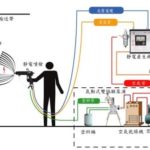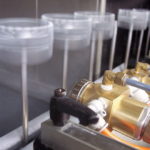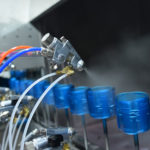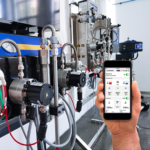
Robotic paint spray is fast growing for high quality and man power saving purpose. Especially for automotive industry, more than half painting service is handled by robot. Robotic spraying not only maintains the adaptation of manual spraying to complex shapes, but also accurate and repeatable. This article will discuss various factors affecting the final coating thickness during robotic spraying.
Why coating thickness control?
For coating applications, film thickness is the most important controlling factor in coating process as by following points:
1- Prevention of coating defects due to improper film thickness.
According to experience, more than half of appearance coating are caused by improper film thickness control. Some common issues such as sagging, thin paint, and undercoating are directly caused by loss control of coating thickness. For example, insufficient coating thickness on bumper will reduce adhesion of the entire coating. When the primer thickness is not reached, the conductive effect will be reduced which will reduce the next stage electrostatic paint transfer rate, which eventually leads to insufficient paint.
2- Help adjust the appearance indicators.
Common paint film appearance indicators such as gloss, color difference, orange peel, DOI, etc. are all based on film thickness control. These indicators are obviously affected by the coating film thickness, especially the top coat thickness. Therefore, coating thickness is the most important control factor in overall coating quality control.
3- Cost control.
In addition to the quality cost of coating thickness control, about half cost of coating is on paint. Precise film thickness control not only help with coating quality, but also cost saving for paint. Statistic analyzing shows when spraying with the same equipment, paint consumption difference is 25% or more whether the film thickness is accurately controlled or not. Following discussion are based on ABB robots
In robotic spray application, the coating film thickness can be calculated as follows:
Dry film thickness = (flow rate × paint volume solid content × paint transfer rate) / (gun speed × spray width)
1) Flow rate, that is, the volume of paint flowing out of gun nozzle per unit time during spraying. In robotic spraying, this data is determined directly in the BRUSH parameter table. In some old-fashioned robotic sprays, flow control did not establish contact with the robotic system and it was not possible to change the flow at any time in spray program. Most of the new robot’s flow control system is directly controlled by the robot IPS system, making flow control more accurate and convenient. For example, in the flow control of ABB robot spraying, there are two types according to whether the flow control is closed or not.
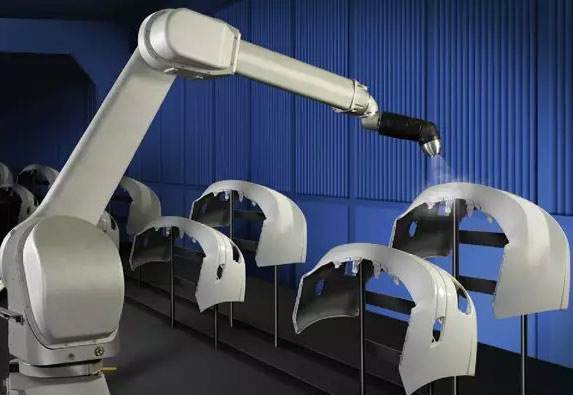
First, closed-loop control is adopted for equipment with high flow accuracy. In closed-loop control, there are two commonly used equipment configurations:
One is to use a metering gear pump, that is, the volume obtained per revolution of the pump is constant, and the robot 1PS system controls the speed of the metering pump to achieve quantitative paint supply. In this type system, the power of the paint comes from the gear pump pressure.
The second is controlled by a closed circuit system consisting of a flow meter and a throttle valve. In this type system, the pressure of the paint is derived from the paint supply system, and the flow signal obtained by the flow meter is transmitted to the robotic IPS system for comparison with the calibrated value. When there is a deviation in the flow rate, the signal is fed back to the throttle valve and adjusted by changing the degree of opening and closing of the throttle valve. When using the second scheme, the stability of the paint supply pressure is high. The robotic spray system provides a multi-stage method of correcting flow deviations. As in the ABBTR5002 spray robot, there are two ways to adjust the deviation of the system.
One can be set by paint characteristics in ROBOTPARAMETRE in robot setting, different settings can be made for each paint system, such as the correction of the flow rate due to the viscosity and relative density of the paint.
Second, it can be set by BRUSH in TEACHPADENT. For example, when the setting in BRUSH is 200 and the actual measured flow rate is 220, the BRUSH ratio can be set to 200/220=91%, so that the actual spraying flow rate becomes 200. It should be noted that the parameters are automatically restored to 100% after this setting is restarted. The selection of the flow range during spraying is mainly affected by two steps: the metering pump and the atomizer. The bottleneck of these two devices determines the range of traffic that can be finally obtained. For example, when using a 6cc metering pump, the rated flow rate of the pump is 0-900mL/min because the controlled speed range of the pump is 0-150r/min. At the same time, there are different flow limits for the atomizer. For example, the upper limit of ABB robot rotary cup ROBOBEL625 is 400mL/min, so in this equipment configuration, the maximum flow rate can only be 400mL/min. Similarly, too low a flow rate when the metering pump is used is too slow to achieve the desired accuracy. Another factor to be concerned is that the amount of flow affects the spray effect of the paint during air spray. According to the experience of robot spraying bumper, it is more suitable to use 20%~70% of the permitted flow rate of the air spray gun, and 20%~100% flow rate of the rotary bell.
2) Paint transfer rate, which refers to the ratio of the final coating adhered to product surface to total flow rate of paint sprayed from spray gun, also known as the paint rate. In fact, the history of entire coating equipment can also be seen as a history of improving the transfer rate of paint, because it is closely related to the two topics of painting manufacturing cost and environmental protection. The main parameters affecting the transfer rate include: atomizer type, electrostatic volum, spray parameters, conductivity etc. The type of spray equipment to use is the first factor in determining the transfer rate because there are significant differences in the transfer rates of different equipments.
Some major paint atomizer transfer rates range from small to large: ordinary air spray guns, electrostatic air spray guns, rotary bell.
Static electricity is the second most important factor affecting the transfer rate of paint. The difference between static electricity and static electricity volume is very obvious during construction. When spraying with electrostatic spraying equipment, the coating particles are charged to let the coating to adsorb on workpiece. Therefore, it is necessary to quickly transfer the charged particles to workpiece to maintain the voltage difference between workpiece and spray gun. To ensure the spatial electric field strength between the two is critical to the paint transfer rate. This adds another factor, that is, the grounding state of workpiece directly affects the coating transfer rate.
This factor is especially noticeable when spraying workpieces that are not conductive, such as plastic bumpers. Tests have shown that when using ROBOBEL spray paint, the transfer rate of general grounding and good grounding products differs by 10% to 20%. For example, the measured transfer rate of the ROBBEL625 SVW2000 sill strip that is grounded by metal clips is about 70%, and only about 50% when the grounding is poor. For air based spray gun, the atomizing air pressure has a greater influence on transfer rate. If the atomizing pressure is too large, the bounced air flow will increase after sprayed onto workpiece, preventing the subsequent small paint particles from reaching the sprayed surface, resulting in a decrease in transfer rate. .
3) Solid content. The solid content parameter usually has two kinds of volume percentage and mass percentage, and the volume percentage is used when calculating the film thickness. In the painting construction, the instability caused by the change of this factor is often neglected. Due to the precise control of other factors in the robot spraying, the influence of this factor is more prominent than in the manual spraying. The following factors may cause instability in solids content of coating during construction:
a- Change in solid content of different batches of paint.
The deviation caused by the solid content of the raw paint control index is generally ±2%, and the influence of such deviation is sometimes large. For example, a paint with a hiding power of 11 μm, the solid content of the original paint is between 27% ± 2%, such that the deviation of the high and low limits is (2925) / 25 = 16%. If its 29% to get a spray film thickness of 12μm, and now 25% can only be sprayed to 12/29×25=10.3μm, obviously the film thickness is not enough. In this case, it is necessary to strictly monitor the solid content of coating material and require the supplier to give a smaller tolerance for sensitive coatings.
b- The deviation caused by the long storage time of paint.
Generally, the coating viscosity will increase with the extension of storage time, and the viscosity of the coating is often used as a control index when formulating. This results in a change in the solids content of the coating that is applied before and after the original paint is stored. such as. A coating has a 10% increase in viscosity after 6 months of storage (this is relatively normal, it will increase if under high temperature), and the thinner to be added when adjusting to the same viscosity will increase comparing to 6 months ago, this reduces the solids content of the formulated paint, and the coating film thickness will decrease if other spray factors remain unchanged.
c- Non-standard paint handling and storage methods will result in a decrease in solid content.
If the original paint is not sufficiently stirred in the drum, the high solids content remains in the barrel, which indirectly reduces the solids content in paint. Also, if the formulated paint is left for too long and sealing is not good, the solid content will increase after solvent is volatilized.
4) Gun speed. Taking the ABBTR5002 painting robot as an example, the gun speed range is 0 to 3000 mm/s. In production, the speed of the general rotary bell is 600~1000mm/s, air spray gun is 800~1500mm/s. In theory, the spraying speed is inversely proportional to the film thickness, but in fact, since the spraying parameters selected at different speeds will indirectly affect the transfer rate, the lower gun speed is preferred under the premise of meeting the spray tempo. Regarding the effect of the gun speed on the transfer rate, it can be explained that the gun speed is slow, the flow rate of the paint used for obtaining the same film thickness is low, and the corresponding atomizing air is also small, which is advantageous for improving the transfer rate. The same is true for a rotary bell, which may be related to the time required for charge transfer. Tests have shown that when the product is sprayed under the same conditions, the transfer rate is increased by 5% at a speed of 700 mm/s than using a speed of 500 mm/s.
5) Spray width. Refers to the width of the coating sprayed by atomizer on workpiece surface. The width of the spray is affected by the following parameters: distance from the sprayed surface to spray gun, atomization and fan parameters (air spray gun) or shaping air (rotary bell). The spray shape of the single-head air spray gun is elliptical, and the spray shape of the rotary cup is circular. The shape of the double-headed spray gun varies according to the angle between the two spray heads, but is basically elliptical. From a spatial perspective, their haze shape is either conical or elliptical. Therefore, when the spray distance becomes shorter, the width of the spray width is proportionally reduced. In the case of air spray gun, the ratio of the atomizing air pressure to the fan air pressure has a linear effect on the width of the spray. Therefore, when modifying the corresponding spray flow rate, it is necessary to consider the spray width which is indirectly affected by the adjustment of the atomization and the fan air value.
For robotic coating programming, ensuring the stability of production process is priorior control. The above five factors affecting film thickness can be controlled and adjusted in different ways.
A In order to ensure the stability of the coating solid content parameters, the following measures are recommended:
- to monitor raw paint solid content, especially for film thickness sensitive coating such as high opacity paint;
- shorten the storage time, use fresh paint as much as possible;
- to avoid high temperature for paint storage;
- standarize paint preparation;
- different seasons use different thinner formulas, can adjust the parameters through the robot IPS to avoid flow changes.
B Spraying speed is adjusted during the preparation process of the spraying track. Once it is determined, it should not be change frequently. It can only be adjusted under certain conditions, such as spraying paint with poor hiding power and paint flow is close to the upper limit. The low speed method is more effective.
C Spray width is mainly determined during the programming. The later adjustment is mainly for some special planes. For example, using a small width for a narrow plane can effectively save the paint. In the adjustment, it is necessary to pay attention to other conditions that affect spray quality due to the change of spray width. For example, when the width is adjusted by spray distance, solvent content of the paint changes at the same time, and corresponding sag or dry spray may occur; When adjust by atomizing fan pressure, it may affect paint atomization effect.
D The coating transfer rate is generally not a factor in the adjustment of production. In production, it is necessary to pay attention to spray quality accident caused by the change of transfer rate. It usually occurs when the paint layer is thinned due to drop of transfer rate. For ex. electrostatic spray gun equipment failure will lead voltage drop and result in transfer rate decreasing.
E Adjust of flow rate is the most frequently used parameter in production. It should be noted that when adjusting the air based spray gun flow rate, the atomization and fan pressure values will change accordingly, which will affect the transfer rate and finally affect the film thickness.
Conclusion
Although the thickness of the paint film is only affected by the five factors discussed above, robotic spraying enhances our ability to control these factors, but because each of these factors is affected by many factors in the entire coating system. Therefore, in the actual production line construction, it is necessary to design an effective monitoring system for construction parameters according to the actual situation to ensure that the film thickness can be controlled and adjustable.

